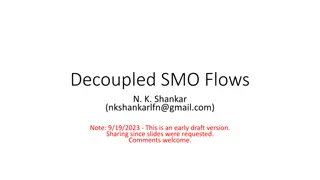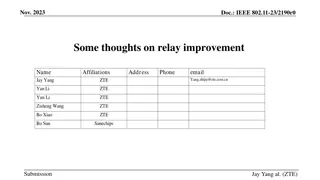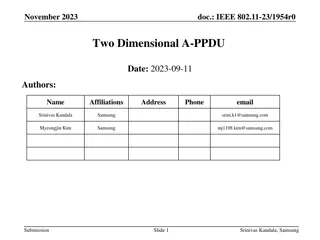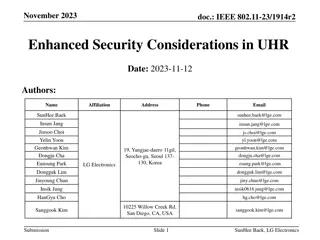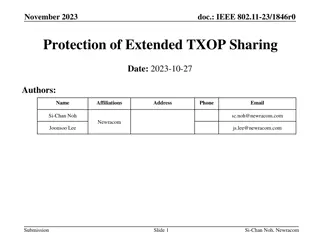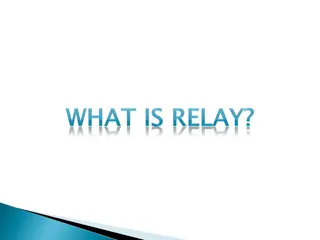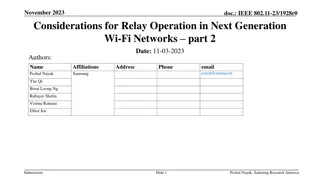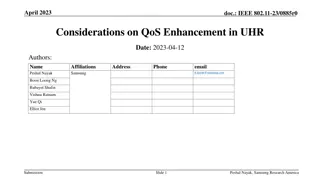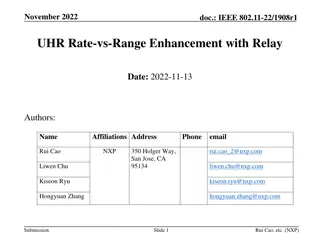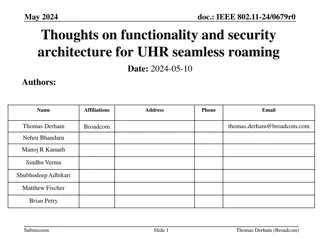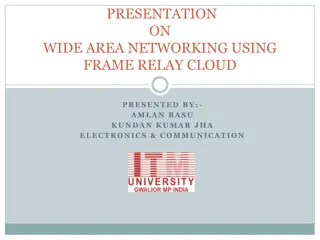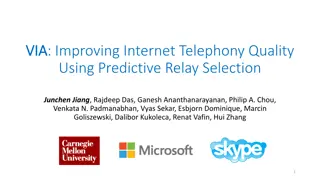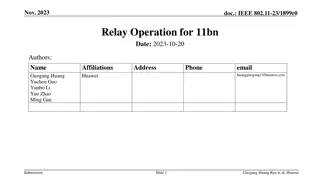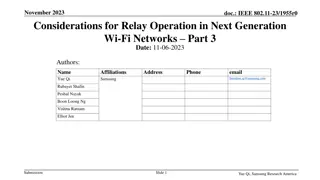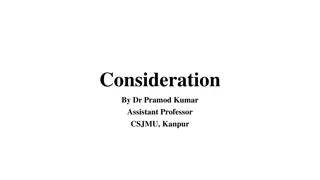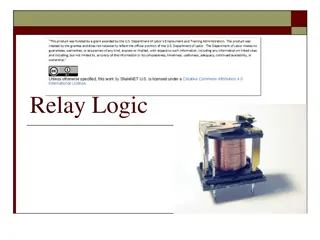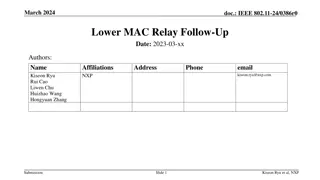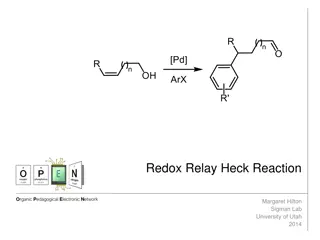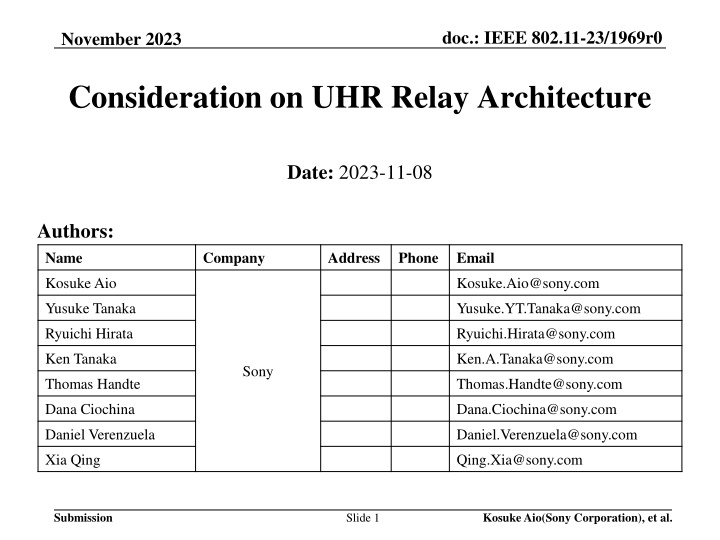
Enhancing Wireless Communication Through UHR Relay Architecture
The document discusses the significance of relay communication in improving Rate-vs-Range throughput in wireless networks. It explores the effectiveness of relay communication for enabling communication between Access Points (APs) and Stations (STAs) and enhancing throughput by improving Signal-to-Noise Ratio (SNR) for STAs with low SNR. The review covers current standards and products related to relay communication and delves into the next-generation relay architecture to further optimize wireless networking capabilities.
Download Presentation

Please find below an Image/Link to download the presentation.
The content on the website is provided AS IS for your information and personal use only. It may not be sold, licensed, or shared on other websites without obtaining consent from the author. If you encounter any issues during the download, it is possible that the publisher has removed the file from their server.
You are allowed to download the files provided on this website for personal or commercial use, subject to the condition that they are used lawfully. All files are the property of their respective owners.
The content on the website is provided AS IS for your information and personal use only. It may not be sold, licensed, or shared on other websites without obtaining consent from the author.
E N D
Presentation Transcript
doc.: IEEE 802.11-23/1969r0 November 2023 Consideration on UHR Relay Architecture Date: 2023-11-08 Authors: Name Company Address Phone Email Kosuke Aio Kosuke.Aio@sony.com Yusuke Tanaka Yusuke.YT.Tanaka@sony.com Ryuichi Hirata Ryuichi.Hirata@sony.com Ken Tanaka Ken.A.Tanaka@sony.com Sony Thomas Handte Thomas.Handte@sony.com Dana Ciochina Dana.Ciochina@sony.com Daniel Verenzuela Daniel.Verenzuela@sony.com Xia Qing Qing.Xia@sony.com Submission Kosuke Aio(Sony Corporation), et al. Slide 1
doc.: IEEE 802.11-23/1969r0 November 2023 Introduction UHR SG defines Rate-vs-Range throughput improvement as scope [1]. Relay communication is effective for improving Rate-vs-Range throughput [2] [5] Relay communication to STAs that cannot receive signals from AP is expected to enable communication between AP and STAs. Relay communication to STAs with low SNR from AP is expected to improve throughput by improving SNR of STAs. This contribution reviews the current standards/products related to relay communication and discusses the next-generation relay architecture. Submission Kosuke Aio(Sony Corporation), et al. Slide 2
doc.: IEEE 802.11-23/1969r0 November 2023 Recap on Relay Communication (1/3) IEEE802.11 spec WDS (Wireless Distributed System) Enable wireless communication between APs (Ad-hoc mode) Mesh (11s) Relay operation and routing to build a mesh network between APs/STAs DMG Relay (11ad) Operation for 60GHz band wireless relay (Link Switching, Link cooperation) S1G Relay (11ah) Operation for sub-1GHz band wireless relay (Implicit Ack, TXOP sharing) Submission Kosuke Aio(Sony Corporation), et al. Slide 3
doc.: IEEE 802.11-23/1969r0 November 2023 Recap on Relay Communication (2/3) Wi-Fi Alliance (Products) EasyMesh Enables wireless relay of multiple installed in-home APs. Define routing and network management by upper layers (PHY/MAC layers aren t target of this spec). AP for wireless relay has both STA Entity and AP Entity. There are lot of products of EasyMesh-like AP. Submission Kosuke Aio(Sony Corporation), et al. Slide 4
doc.: IEEE 802.11-23/1969r0 November 2023 Recap on Relay Communication (3/3) Relay type Full-Duplex vs. Half-Duplex FD (Full Duplex) : Can transmit Fronthaul/Backhaul simultaneously Both In-band and Out-band HD (Half Duplex) : Cannot transmit Fronthaul/Backhaul simultaneously Amplify and Forward vs. Decode and Forward AF (Amplify and Forward) : Received signals are amplified and relayed without decoding DF (Decode and Forward) : Received signals are decoded, re-coded, amplified and relayed Enabled relay type for each spec/feature Spec Feature FD-AF FD-DF HD-AF HD-DF WDS Mesh 802.11 DMG Relay S1G Relay WFA EasyMesh Submission Kosuke Aio(Sony Corporation), et al. Slide 5
doc.: IEEE 802.11-23/1969r0 November 2023 Future Directions of Relay Architecture Since coverage extension with high reliability is required for next generation Wi-Fi, it is desirable to decode once at the relay node. AF (Amplify and Forward) accumulates noise, making it difficult to improve reliability. Currently, many standards/products can be configured for Out-Band Full- Duplex (FD) and we should consider on this type. In S1G Relay and EasyMesh, it is assumed that the relay node has both STA Entity and AP Entity, and each can be configured with a different channel (band). The relay node can be just after the MAC SAP (for S1G Relay) or in the DS (Distributed System) (for Easy Mesh). In both cases, the relay operation is performed after all processing at MAC layer is completed. Of course, a more simplified relay node could be introduced. Submission Kosuke Aio(Sony Corporation), et al. Slide 6
doc.: IEEE 802.11-23/1969r0 November 2023 Issues of Current Relay Node When relaying packets after processing in MAC layer, throughput may be reduced because some packets are buffered in the "Reordering Buffer". When some packets are lost on the backhaul, packets after the lost packet are buffered in Reordering Buffer of the relay device. (packets before the lost packet are transferred to STA). In this case, even if the channel of Fronthaul link is idle, sufficient relay transmission is not performed, resulting in a decrease in throughput (longer transmission time). : Backhaul Link : Fronthaul Link Submission Kosuke Aio(Sony Corporation), et al. Slide 7
doc.: IEEE 802.11-23/1969r0 November 2023 New Architecture: Relay MLD Node Relay MLD Node: Newly defined node that relays before Reordering Buffer using MLO Architecture. Relay MLD Node: MLD with both STA Entity and AP Entity By relaying in the middle of MAC layer to skip Reordering Buffer, packets after the lost packet in Backhaul can be relayed sequentially. It is expected to avoid throughput degradation during relay communication. Further reduction of latency may be expected by skipping some blocks (Encryption/Decryption, Linux layer, and so on). : Backhaul Link : Fronthaul Link Submission Kosuke Aio(Sony Corporation), et al. Slide 8
doc.: IEEE 802.11-23/1969r0 November 2023 Simulation Parameters Evaluated the performance of Relay MLD Node Scenario : Backhaul Link : Fronthaul Link Parameter (Data) Packet Size Num. of Packets Max Aggregation Size PPDU MCS BW Tx Spatial Stream 1500 byte 280 256 HE, short Guard Interval Fix: MCS11 (1024QAM 5/6) 80MHz 2 From 0% To 10% For both Backhaul/Fronthaul Source STA Relay Full Duplex : Backhaul & Fronthaul are set to different channel and can transmit simultaneously. Relay node can start transmission after receiving a MPDU. Same parameters of Backhaul/Fronthaul. Both Source/Relay have already obtained TXOP. Packet Error Rate Metric Effective throughput is calculated from the time required to complete all packet transmissions (Transmission Time) Normal Relay : Only successfully acquired packets before the lost packet in backhaul are relayed. MLO Relay : All successfully acquired packets in backhaul are relayed. Submission Kosuke Aio(Sony Corporation), et al. Slide 9
doc.: IEEE 802.11-23/1969r0 November 2023 Simulation Results CDF of Effective Throughput 50%-tile Effective Throughput vs PER x1.42 x1.42 x1.42 Under PER=10% environment, enabling relay transmission without Reordering Buffer is expected to improve effective throughput by nearly 1.4x. Submission Kosuke Aio(Sony Corporation), et al. Slide 10
doc.: IEEE 802.11-23/1969r0 November 2023 Discussion Points Relay MLD Node architecture needs further study We only considered about Reordering Buffer here, but there are various trade-offs depending on the point of relay communication. For example Encryption/Decryption If Relay MLD Node can skip Encryption/Decryption, the processing time can be shortened, and the transmission delay may be reduced. However, an association between Source Node and STA is required, so an additional association process will need to be defined. Scoreboard If Relay MLD Node can have a Scoreboard, retransmission processing through the Relay Node can be implemented. However, Relay MLD Node must hold the relayed packets for a certain period. Spec impact of an MLD having both AP Entity and STA Entity also needs to be considered. Submission Kosuke Aio(Sony Corporation), et al. Slide 11
doc.: IEEE 802.11-23/1969r0 November 2023 Summary We reviewed the current standards/products related to relay communication and discusses the for next-generation relay architecture. From spec/product aspects both, Out-band Full Duplex and Decode and Forward relay communication will be major for next generation Wi-Fi. We proposed new relay architecture: Relay MLD node and evaluated the performance. By skipping Reordering Buffer, effective throughput was improved by nearly 1.4x under PER=10%. There are many future discussion points about the detail architecture. Submission Kosuke Aio(Sony Corporation), et al. Slide 12
doc.: IEEE 802.11-23/1969r0 November 2023 Reference [1] Laurent Cariou (Intel), UHR proposed PAR, 23/0480r3, July 2023 [2] Rui Cao (NXP), UHR rate-vs-range enhancement with relay, 22/1980r1, Nov 2022 [3] Dongguk Lim (LG Electronics), Features to consider for efficient Relay operation, 23/1138r1, July 2023 [4] Serhat Erkucuk (Ofinno), Relaying for Low Latency Traffic in UHR, 23/1146r1, July 2023 [5] Kiseon Ryu (NXP), UHR relay follow up, 23/1175r0, Aug 2023 Submission Kosuke Aio(Sony Corporation), et al. Slide 13
doc.: IEEE 802.11-23/1969r0 November 2023 Appendix BER Analysis (Backhaul BER (256QAM, AWGN, LDPC)) 1.E+00 1.E-01 1.E-02 1.E-03 Bit Error Rate 1.E-04 AF Relay 1.E-05 DF Relay BER < 1e-9 at SNR >= 35dB BER < 1e-9 at SNR > 25 1.E-06 1.E-07 1.E-08 1.E-09 10 15 20 25 30 35 40 SNR (dB) Submission Kosuke Aio(Sony Corporation), et al. Slide 14


